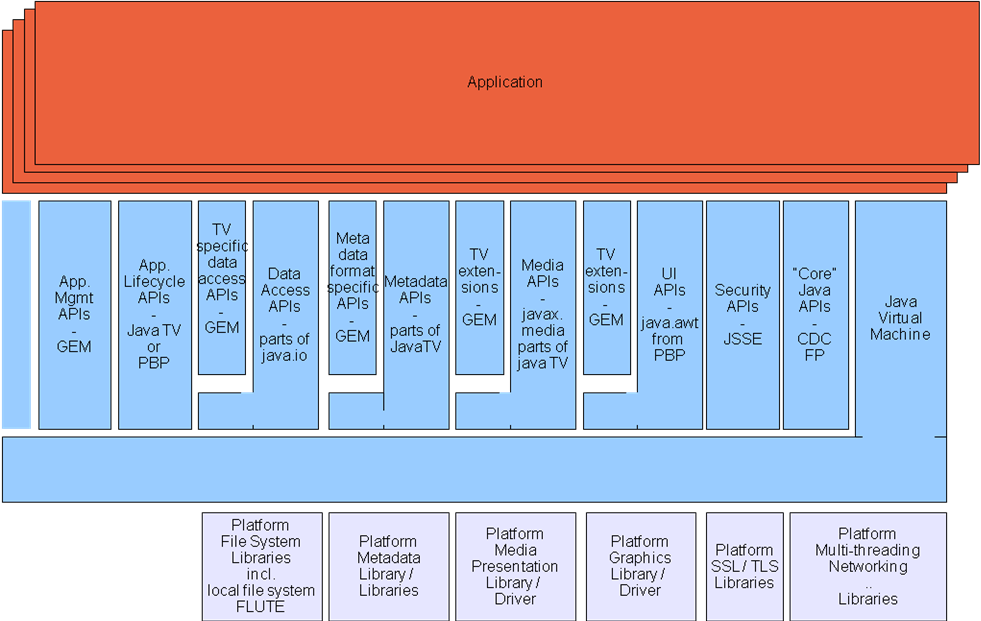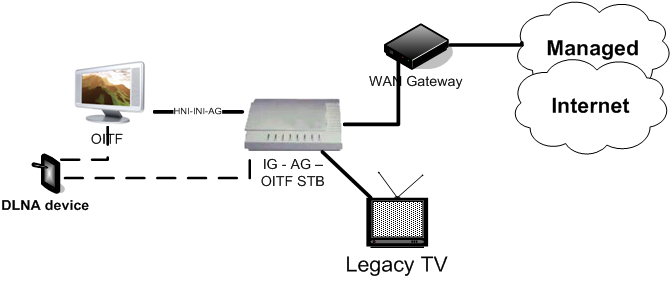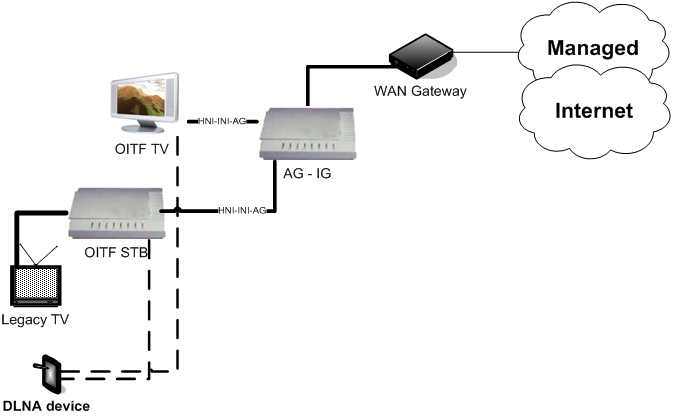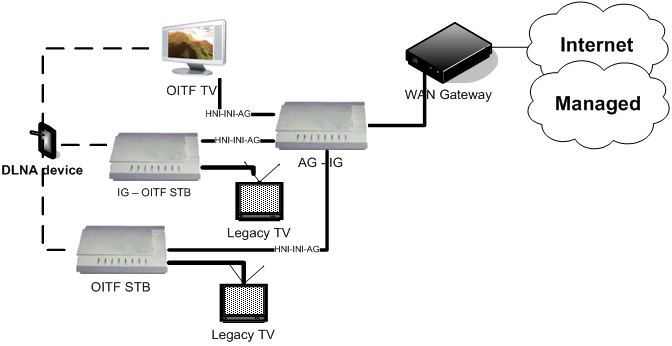The following table lists which clauses of the present document are REQUIRED or OPTIONAL for the 3 different device types addressed by this volume.
Table ####: Applicability of GEM Specification Sections
| Area | GEM Specification Section | GEM IPTV Target | PAE Devices With Display | PAE Devices Without Display |
|---|
| Without Media Handling | With Media Handling |
|---|
| Static Formats |
| Bitmap pictures | 7.1.1.3, "PNG" and 15.1, "PNG — restrictions" | M | M | - | - |
| 7.1.1.3, "PNG" without restrictions | - | - | - | - |
| 7.1.1.4, "GIF" | - | M
Required by PBP | - | - |
| 7.1.2, "MPEG-2 I-Frames" | O | SN | - | - |
| 7.1.1.2, "JPEG" + 15.3, "JPEG — restrictions" | - | - | - | - |
| 7.1.1.2, "JPEG" without restrictions | M | M | - | - |
| Audio clips | 7.1.4, "Monomedia format for audio clips" | M | M-FE | - | O-FE |
| Video drips | 7.1.3, "MPEG-2 Video "drips" | O | SN | - | - |
| Text encoding | 7.1.5, "Monomedia format for text" | M | M | M | M |
| Media Streaming Formats |
| Video | 7.2.2, "Video" | M | M-FE | - | - |
| Audio | 7.2.1, "Audio" | M | M-FE | - | O-FE |
| Subtitles | 7.2.3, "Subtitles" | - | O | - | - |
| Fonts |
| Built in | Character, set see annex E
Metrics see annex D
Face: UK RNIB "Tiresias" | O | M | - | - |
| Downloadable | 7.4.1, “PFR” | M | SN | - | - |
| 7.4.2, “OpenType” | O | M | - | - |
| Broadcast channel protocols |
| 6.2.2, "MPEG-2 sections" | O | Not visible to GEM applications | - | Not visible to GEM applications |
| 6.2.5, "Object carousel" | O | M/-
Partial functional equivalent | M/-
Partial functional equivalent | M/-
Partial functional equivalent |
IP Multicast stack based on:
6.2.6, "Protocol for delivery of IP multicast over the broadcast channel",
6.2.7, "Internet Protocol (IP)",
6.2.8, "User Datagram Protocol (UDP)",
6.2.10, “IP signalling”
| - | - | - | - |
| Interaction channel protocols |
| TCP/IP | 6.3.3, "Transmission Control Protocol", 6.3.2, "Internet Protocol" | M | M | M | M |
| UDP/IP | 6.3.2, "Internet Protocol", 6.3.9, "User Datagram Protocol" | M | M | M | M |
| HTTP | 6.3.7.1, "HTTP 1.1" | O | M | M | M |
| 6.3.7.2, “MHP profile of HTTP 1.0” | M | - | - | - |
| DSMCC-UU RPC | 6.3.4, "UNO-RPC",
6.3.5, "UNO-CDR",
6.3.6, "DSM-CC User to User" | - | - | - | - |
| DNS | 6.3.10, "DNS" | M | M | M | M |
| HTTPS | 6.3.7.3, “HTTPS” | M | M | M | M |
| Interaction Channel File System | 6.4.1, “File system implemented only by the interaction channel” | O | - | - | - |
| DSMCC / HTTP hybrid | 6.4.2, “Hybrid between broadcast stream and interaction channel” | O | - | - | - |
| IPTV | 5, “Basic architecture” | M | - | - | - |
| Application Model |
| ApplicationModel | All parts of clause 9, “Application model” except those clauses (and their subclauses) identified below | M | M | M | M |
| 9.3 ”DVB-HTML model” | O | SN | SN | SN |
| 9.7, “Lifecycle of internet access applications” | O | M/O
Only web browser support is REQUIRED | - | - |
| 9.9, “Stored and Cached applications” | O | M/O
Stored application support REQUIRED | M/O
Stored application support REQUIRED | M/O
Stored application support REQUIRED |
| 9.13, “Unbound Applications” | - | M | M | M |
| Application Signalling |
| Application Signalling | 10, “Application signalling” | M | M-FE
XML encoding of AIT does not support full syntax of binary encoding. | M-FE
XML encoding of AIT does not support full syntax of binary encoding. | M-FE
XML encoding of AIT does not support full syntax of binary encoding. |
| DVB-J |
| All parts of clause 11, “DVB-J platform” except those clauses (and their subclauses) identified below | M | M | Subset as defined by [[!HEADLESS]] | Subset as defined by [[!HEADLESS]] |
| 11.4.1 “ HAVi UI Widgets” | O | O | - | - |
| 11.5.2, "Support for Multicast IP over the Broadcast Channel | - | - | - | - |
| 11.5.3, "Support for IP over the Return Channel" | M | M | M | M |
| 11.5.4, "MPEG-2 Section Filter API" | O | SN | SN | SN |
| 11.5.5, "Mid-Level Communications API" as modified by 11.5, "Data access APIs" | M | M | M | M |
| 11.5.7 “File storage device access” | O | O | O | O |
| 11.6.3, "Tuning API" | O | - | - | - |
| 11.6.4, "Conditional access API" | - | - | - | - |
| 11.6.6, ”Service discovery and selection for IPTV” | O | M | M | M |
| 11.6.7, “Integration between protocol independent SI API and TV-Anytime” | O | M/-
Mandatory if broadband content guide is supported otherwise not applicable | M/-
Mandatory if broadband content guide is supported otherwise not applicable | M/-
Mandatory if broadband content guide is supported otherwise not applicable |
| 11.7.4, "Basic MPEG concepts" | O | - | - | - |
| 11.7.6 “Content referencing” | O | M | M | M |
| 11.7.7, "Common error reporting" | O | - | - | - |
| 11.7.8, “Plug-in APIs” | O | O | O | O |
| 11.7.9, “Provider API” | O | O | O | O |
| 11.7.10, “Content referencing for IPTV” | O | M | - | M |
| 11.7.11, “TV-Anytime content referencing and metadata | O | M/-
Mandatory if broadband content guide is supported otherwise not applicable | M/-
Mandatory if broadband content guide is supported otherwise not applicable | M/-
Mandatory if broadband content guide is supported otherwise not applicable |
| 11.8.2, "APIs for return channel security" | M | M | M | M |
| 11.8.3, "Additional permissions classes" | O | - | - | - |
| 11.8.6, “DVB Extensions for Cryptography” | O | O | O | O |
| 11.9.5.2, “JDOM” | O | M | M | M |
| 11.9.6, “MHP terminal hardware API” | O | O | O | O |
| 11.11.1 “Transport stream” | O | - | - | - |
| 11.11.2 “Network” | O | - | - | - |
| 11.11.4.3, “Content referencing for IPTV” | M | M | - | M |
| 11.11.5 ”DVB event” | O | - | - | - |
| 11.11.9 “Drip feed decoder” | O | SN | SN | SN |
| 11.12.2, “Stored services” | O | M | M | M |
| 11.15, “APIs defined in OCAP” | O | M/O
Only org.ocap.service is REQUIRED | M/O
Only org.ocap.service is REQUIRED | M/O
Only org.ocap.service is REQUIRED |
| 11.14, “Internet Access” | O | M/O
Only web browser support is REQUIRED | - | - |
| 17, “Internet access clients” | O | M/O
Only web browser support is REQUIRED | - | - |
The following table gives an overview of the functional equivalents that are available in the GEM-IPTV target and are defined in the PAE.
Table ####: Summary of Functional Equivalents (Informative)
| Name | GEM Clause(s) | MHP Definition | Details |
|---|
| Arch | 5, "Basic architecture" | MHP [1], clause 5, "Basic Architecture" | See section "" |
| Carousel | 6.2.5, "Object carousel" | MHP [1], clause 6.2.5, "DSMCC User-to-user Object Carousel" as modified by clause 15.6.1.1, "Carousel" | No complete functional equivalent defined. JAR files are a partial functional equivalent. See section "" |
| IP MPE | 6.2.6, "Protocol for delivery of IP multicast over the broadcast channel" | MHP [1], clause 6.2.6, "DVB Multiprotocol Encapsulation" | Not applicable |
| SI | 6.2.9, "Service information" | MHP [1], clause 6.2.9, "DVB Service Information" DVB Service Information as defined in EN 300 468 [4] and ETR 211 [11]. | DVB-SD&S and BCG. |
| 11.6.1, "Signalling-bound service information API" | MHP [1], clause 11.6.1, "DVB Service Information API" MHP [1], clause 11.11.3, "Bouquet" | Not defined. |
| Annex O, "Integration of the JavaTV SI API" | MHP [1], annex O, "Integration of the JavaTV SI API" | MHP Annex AP mapping between JavaTV SI API and SD&S / BCG. |
| Broadcast IP signalling | 6.2.10, "IP signalling" | MHP [1], clause 6.2.10, "IP signalling" | Not applicable |
| IPTV Protocols | 6.5, “IPTV protocols” | MHP [1], clause 6,5, “IPTV protocols” | RTP, RTSP, IGMP, DVB-STP as defined in section "". |
| Audio | 7.2.1, "Audio" At least 1 audio format. | MHP [1], clause 7.2.1, "Audio" | HE-AAC - see section "" |
| Video | 7.2.2, "Video" At least 1 audio format. | MHP [1], clause 7.2.2, "Video" | HE-AAC - see section "" |
| Subtitles | 7.2.3, "Subtitles" | MHP [1], clause 7.2.3, "Subtitles" | Optional in the present document |
| 11.4, "Presentation APIs" - classes related to subtitles | MHP [1], clause 11.4.2.5.1, classes related to subtitles | If no subtitle format selected then APIs do nothing |
| Audio Clips | 7.1.4, "Monomedia format for audio clips" | MHP [1], clause 7.1.4: Functional equivalent to MPEG-1 Audio (Layer 1 and 2) ISO/IEC 11172-3 | HE-AAC REQUIRED and MPEG-1 layer 3 OPTIONAL - see section "". |
| Resident Fonts | 7.3, "Resident fonts" | MHP [1], clause 7.3 At least the font Tiresias [80] shall be provided. | Tiresias or equivalent with extended latin character set. |
| Downloadable Fonts | 7.4, "Downloadable fonts" | MHP [1], clause 7.4 PFR0 as in DAVIC 1.4.1p9 [3] OpenType® as defined in ISO/IEC 14496-18 [115] as the font format for MPEG-4 | OpenType REQUIRED with clarifications from GEM. |
| Application Signalling | 10.2, "Program specific information" 10.4, "Application description" 10.5, "DVB-J specific application description" | MHP [1], clause 10 | XML encoding of AIT defined in MHP Annex AR. |
| 11.7.2, "Application discovery and launching APIs" | MHP [1], clause 11.7.2, "Application discovery and launching APIs" | Same mapping as MHP. See clause - "". |
| Application Authentication | 12.2, "Authentication of applications" NOTE 1: See also text in clause 12.6.2.6, "Credentials" and text in clause 12.9, "Certificate management" NOTE 2: See also text in clause 12.9.2, "Root certificate management." | MHP [1], clause 12.2, "Authentication of applications" | Signed Jar files. |
| 12.9.1, "Certificate Revocation Lists" | MHP [1] clause 12.9.1, "Certificate Revocation Lists" | Optional in the present document. |
| Conditional Access | 11.4, "Presentation APIs," classes related to conditional access | MHP [1], clause 11.4.2.5.1, classes related to conditional access | Failure modes due to content protection are included. |
| 11.6.4, "Conditional access API" | MHP [1], clause 11.6.4, "Conditional Access API" MHP [1], clause 14.10, "CA system" | Not included in the present document. |
| Content Referencing | 11.7.6, "Content referencing" | MHP [1], clause 11.7.6, "Content Referencing" This API is formed of DAVIC 1.4.1p9 [3] Locator, DvbLocator, javax.tv.locator, org.dvb.locator.packages | Supported as defined in GEM. Classes corresponding to “dvb:” URI scheme not included. |
| 11.11.11, "Methods working on many locator types" | MHP [1], clause 11.11.11, "Methods working on many Locator types" | There are no transport independent locators defined in the present document. |
| 14.1, "Namespace mapping" | MHP [1], clause 14.1, "Namespace mapping (DVB Locator)" | See section "". |
14.9 Content referencing for IPTV 14.10, "Service identification" | MHP [1], clause 14.9, "Service identification" | Not applicable. |
| Graphics Resolution | D.2, "Horizontal resolution" | MHP [1], clause D.3.4.2, "Horizontal resolution" | |
| G.1.1, "Device resolution for Standard Definition" | MHP [1], clause G.1.1, "Device capabilities" | See [[.OIPF_DAE2]]. |
| G.4, "Resident fonts and text rendering" | MHP [1], clause G.4, "Resident fonts and text rendering" | |
| Text Wrapping | D.3, "Text wrapping setting is true" | MHP [1], clause D.3.7.2, "Text wrapping setting is true" | |
| RCMM | 12.9.2, "Root certificate management" | MHP [1], clause 12.9.2, "Root Certificate Management" | Not defined in the present document. |
| Active Format Descriptor | N.1, "Active Format Definition" | Described in the present document, clause N.1.1, "MHP Signalling for Active Format Definition" | Not defined in the present document. |




